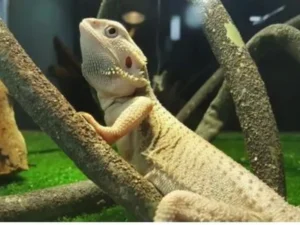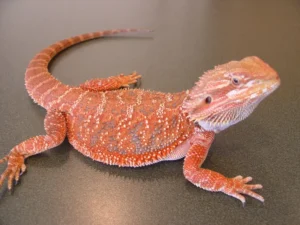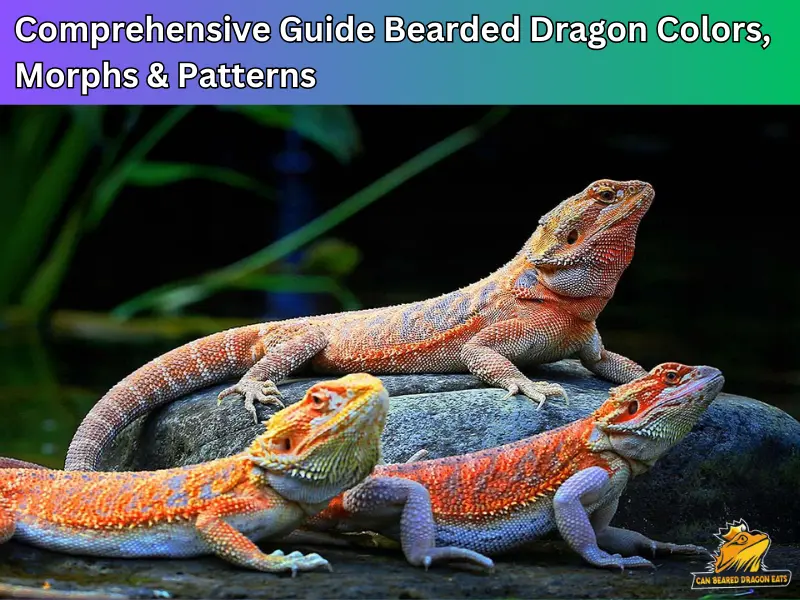Bearded dragons have unique personalities but also for their stunning array of colors, intricate patterns, and mesmerizing morphs.
They have a spectrum of hues from vibrant oranges and fiery reds to subtle pastels and striking blacks. With their intricate patterns ranging from bold stripes to delicate speckles, each bearded dragon boasts its individualistic charm.
Moreover, the fascinating morphs of bearded dragons introduce a unique dimension, where genetic variations give rise to an astonishing diversity of appearances.
In this post, we will share different morphs, patterns, and colors of bearded dragons. Read on to get more!
Read more : How to Setup A Bearded Dragon Habitat?
What is Morph In Bearded Dragons?
For reptiles like bearded dragons, a morph refers to a particular variation or phenotype resulting from selective breeding or natural genetic mutations. These variations can affect color, pattern, scale structure, and other physical characteristics.
Morph breeding has become popular among reptile enthusiasts, leading to the development of numerous visually striking variations. Each morph is typically given a specific name to distinguish it from others.
What Are the Colors of a Bearded Dragon?
Bearded dragons can encounter various skin color problems, which indicative of health issues or environmental factors.
Here’s a detailed overview:
Normal Skin Coloration
Healthy bearded dragons typically exhibit a range of skin colors.
- Tan: Often the base color, ranging from light beige to darker earthy tones.
- Brown: Commonly seen as patches or bands, adding depth to the overall coloration.
- Yellow: Vibrant yellows can accentuate various body parts, especially under proper lighting conditions.
- Orange: Typically found in vivid hues, particularly on the beard, tail, or limbs.
- Green: Occasional hints of green can appear, especially in the undertones or along the sides, though less common than other colors.
Their skin should appear smooth, without any lesions, discoloration, or abnormal texture.
Read more : Do Bearded Dragons Shed Their Skin?
Abnormal Skin Coloration
If a bearded dragon’s skin appears unusually pale, dark, or discolored in patches, it could indicate underlying health issues. For example:
- Pale Skin: Paleness might indicate stress, illness, or a lack of proper UVB lighting, which is essential for their health.
- Dark Skin: Darkening of the skin can be a sign of stress, overheating, or potentially a symptom of a health problem such as metabolic bone disease.
- Red or Inflamed Skin: Redness or inflammation could be a sign of irritation, injury, or an underlying infection.
- Blackened Skin: Black patches on the skin might indicate necrosis (tissue death), bruising, or other severe health issues.
What About Albino Breded Dragon & Leucism?
Albino bearded dragons are a selectively bred variation characterized by their lack of melanin pigment, resulting in a striking white or pale appearance. These dragons have translucent skin and vibrant red or pink eyes due to the absence of melanin in their eyes.
Their scales lack the typical coloration of wild-type dragons, giving them a unique and ethereal appearance. Despite their stunning aesthetics, albino dragons require special care, including UVB lighting supplementation and protection from excessive sunlight due to their lack of pigmentation, which makes them more susceptible to sunburns and other skin issues.
Unlike albinism, leucism retains some pigmentation in the eyes. Both variants are popular among reptile enthusiasts for their unique aesthetics. However, due to their lack of melanin, albino bearded dragons are more susceptible to sunburn and require careful UVB exposure management. Leucistic dragons also require proper care to maintain their health and vibrancy.
Change in Bearded Dragons Skin Color
Bearded dragons regularly shed their skin as they grow. During shedding, their skin appears dull or grayish before peeling off in patches. It’s essential to ensure proper humidity levels and provide rough surfaces for them to rub against during shedding to help facilitate the process.
Skin Problems In Bearded Dragons
Bearded dragons are susceptible to various skin problems, including:
Parasites
External parasites like mites can cause irritation, redness, or lesions on the skin.
Fungal Infections
Fungal infections can lead to discoloration, lesions, or abnormal shedding.
Bacterial Infections
Bacterial infections can cause inflammation, redness, and sometimes pus-filled abscesses on the skin.
Burns
Improper heating elements or inadequate basking spots can cause burns on the skin, leading to discoloration, blisters, or tissue damage.
Read more : Can Bearded Dragons Eat Red Wigglers?
Bearded Dragons Pattern
Bearded dragons exhibit a variety of skin patterns, with some common variations:
- Banded: Bands or stripes running along the body, often in shades of brown or black.
- Spotted: Irregular spots or speckles across the skin, resembling freckles.
- Mottled: Blotchy patterns with irregular shapes and sizes.
- Striped: Straight or curved lines extending along the body.
- Barred: Thick, horizontal bars or stripes, particularly prominent on the tail.
- Blotched: Large, irregular patches of color distributed across the skin.
- Marbled: Intricate patterns resembling marble stone, with swirls and veins of different colors.
These patterns can vary in intensity and distribution among individual bearded dragons, contributing to their unique appearance.
11 Coolest Bearded Dragon Morphs
Well, all bearded dragons morph but all types of bearded dragons morph differently.
1. Zero Morph Bearded Dragon
Rare bearded dragon morphs encompass a fascinating array of unique variations within the bearded dragon community. Among these, the rarest bearded dragon morph is undoubtedly the bearded dragon zero morph. Zero morph bearded dragons are prized for their stunning lack of dark pigmentation, resulting in a captivating appearance dominated by bright oranges, yellows, and whites.

These dragons exhibit a vibrant coloration that seems to glow under light, making them stand out in any collection. The absence of dark pigmentation gives zeros a clean and crisp aesthetic, with their scales often displaying a translucent quality that enhances their overall brightness. Breeders and enthusiasts are drawn to zeros for their bold and striking appearance, which adds a unique pop of color to any habitat or breeding project.
Due to their distinct lack of dark markings, zeros showcase a purity of color that is unparalleled in the bearded dragon world, making them highly sought after among collectors and hobbyists alike.
2. Red Morph Bearded Dragon
When it comes to the red morph bearded dragon, enthusiasts often seek out these stunning reptiles for their captivating appearance. From their earliest stages as a red morph bearded dragon baby to adulthood, the allure of their rich and vibrant coloration remains unparalleled.
These dragons typically exhibit deep crimson, ruby, or brick-red hues that intensify with age and proper care, captivating onlookers with their striking presence. The vivid red coloration extends seamlessly across their body, from their delicate heads to the tip of their tails, creating a mesmerizing and eye-catching display.

As these dragons mature, questions arise about their eventual size.
Indeed, many wonder, “How big do red-morph bearded dragons get?” Regardless of their size, one thing remains certain: red morphs exude elegance and confidence, making them prized additions to any reptile collection.
3. Blue Bearded Dragon Morph
Blue bearded dragon morphs captivate with their striking and uncommon coloration, which ranges from soft pastel blues to vibrant azure hues. These dragons often exhibit a uniform blue coloration across their scales, creating a mesmerizing and ethereal appearance. Blue morphs may also feature subtle variations in shade, adding depth and dimension to their overall color palette.
While lounging in their terrarium or exploring their surroundings, blue morphs stand out as captivating specimens that inspire awe and admiration.
4. Leatherback Morph Bearded Dragon
Leatherback morph bearded dragons boast a unique and tactile appearance characterized by smooth, scale-reduced skin. These dragons exhibit a softer texture compared to their scaled counterparts, with a distinctive lack of pronounced scalation along their dorsal ridge.
The absence of scales often enhances the visibility of their underlying colors and patterns, resulting in a sleek and streamlined aesthetic. Leatherbacks are prized for their velvety touch and striking appearance, which combines the best qualities of both texture and color.
While observed up close or admired from afar, leatherback morphs captivate with their elegant and understated beauty, making them highly sought after among reptile enthusiasts.
5. Black Bearded Dragon Morph
Black bearded dragon morphs are renowned for their striking and dramatic coloration, which ranges from deep charcoal to jet black. These dragons exhibit a rich and velvety black hue that extends across their entire body, creating a sleek and sophisticated appearance.
The intensity of their coloration is further accentuated by contrasting lighter tones on their undersides, adding depth and dimension to their overall aesthetic. Black morphs exude an air of mystery and allure, drawing the gaze of admirers with their commanding presence.
6. Paradox Morph Bearded Dragon
Paradox morphs bearded dragons defy conventional color patterns, exhibiting unexpected patches or streaks of contrasting colors within their scales. These unique markings can result from genetic mutations or environmental factors during development, creating visually stunning and one-of-a-kind individuals.
Paradox dragons showcase a kaleidoscope of colors and patterns, ranging from vibrant oranges and yellows to deep blues and greens. Each paradox dragon is a living work of art, with its own distinct combination of colors and markings that mesmerize and captivate observers.
7. Rainbow Blue Bearded Dragon Morph
Rainbow blue bearded dragon morphs are characterized by their stunning and vibrant array of blue hues, which span the spectrum from pale sky blue to deep indigo. These dragons exhibit a kaleidoscope of colors across their scales, creating a mesmerizing and iridescent appearance reminiscent of a rainbow.
Rainbow blue morphs may also display subtle hints of other colors, such as green or purple, adding depth and complexity to their overall aesthetic.
8. Dunner Morph Bearded Dragon
Dunner morph bearded dragons exhibit a distinctive pattern of raised scales along their dorsal ridge, resembling tiny “horns” or spikes. This morph adds texture and depth to their appearance, creating a visually striking effect. Dunners often display vibrant colors and intricate patterns, making them stand out in any collection.
These bearded dragon dunner morphs possess a unique tactile appeal, with their raised scales inviting touch and exploration. Dunner morphs captivate with their bold and dynamic appearance, which showcases the beauty of nature’s diversity.
9. Citrus Morph Bearded Dragon
Citrus morph bearded dragons are known for their vibrant and zesty coloration, which ranges from bright oranges and yellows to vivid greens.
These dragons exhibit a citrus-inspired palette that evokes the fresh and tangy flavors of their namesake fruits. Citrus morphs often display a combination of bold colors and striking patterns, creating a visually stimulating and eye-catching appearance.
While lounging in their terrarium or exploring their surroundings, citrus morphs stand out as captivating specimens that inspire joy and admiration.
10. German Giant Morph Bearded Dragon
German giant morph bearded dragons are renowned for their impressive size and robust build, which set them apart from other morphs. These dragons exhibit a larger-than-average stature, with broad shoulders and muscular limbs that reflect their robust genetics.
German giants often display vibrant colors and intricate patterns, further enhancing their imposing presence. Enthusiasts are drawn to the size and strength of German giant bearded dragons, which exude an air of power and authority.
While basking in the warmth of their habitat or surveying their surroundings, German giants command attention as formidable specimens that inspire awe and admiration.
11. Translucent Morph Bearded Dragon
Translucent morph bearded dragons possess semi-transparent scales, giving them a distinctively translucent appearance. This morph often results in a lighter overall coloration, with some individuals displaying subtle hues of greens and blues. Their translucent skin allows for a fascinating glimpse into their internal structures, adding to their allure.
Translucent morphs are prized for their ethereal beauty and unique aesthetic, which sets them apart from other morphs. While basking in the sunlight or exploring their surroundings, translucent bearded dragons captivate with their otherworldly appearance, inviting observers to marvel at the wonders of nature.
Read more : Can Bearded Dragons Eat Chard?
What is Fake Bearded Dragon Morphs
Fake” bearded dragon morphs are essentially misrepresentations or misconceptions about the genetics or breeding of bearded dragons. These can arise for various reasons, including misunderstanding of genetics, intentional deception by sellers, or marketing tactics to promote certain traits as unique or desirable.
A few examples of what might be considered “fake” bearded dragon morphs are:
- Mislabeling: Sellers falsely advertise ordinary dragons as rare morphs to hike prices.
- Hybridization: Hybrids are marketed as unique morphs, blurring true genetics.
- Unrecognized Traits: Unique traits not officially recognized as morphs need to be clarified for buyers.
- Exaggeration: Sellers overhype traits to boost demand and justify higher prices.
- Poor Definitions: Some morph names lack clear standards, leading to inconsistency in labeling.
FAQs
Do bearded dragons change color?
Yes, bearded dragons can change color. They darken or lighten their skin in response to temperature, stress, mood, or environmental changes. Color changes can also occur during shedding or as a reaction to social interactions with other bearded dragons.
What colors can bearded dragons see?
Bearded dragons can see a broad spectrum of colors, including ultraviolet (UV) light, which humans cannot see. This advanced color vision helps them identify food, detect predators, and communicate with other dragons, enhancing their ability to navigate and survive in their environment.
What is the rarest Colour of a bearded dragon?
Purple and blue are the rarest colors of bearded dragons
Can bearded dragons see in color?
Yes, bearded dragons can see in color. Their vision encompasses a wide range of colors, including ultraviolet light. This capability allows them better to recognize food, mates, and potential threats, making their color vision crucial for their daily activities and overall survival.
Read more : Can bearded dragons eat carrots?
The Bottom Line
The world of bearded dragons is rich with a mesmerizing array of colors, patterns, and morphs, each offering a unique glimpse into these remarkable reptiles’ genetic diversity and beauty. From the vibrant hues of the red morph bearded dragon baby to the ethereal translucence of the bearded dragon zero morphs and the textured elegance of the leatherback and dunner morphs, each variation brings its own charm and appeal.
If you’re an experienced breeder, a passionate collector, or a new enthusiast, the wide range of rare bearded dragon morphs provides endless opportunities to explore and appreciate these fascinating creatures. Understanding the distinct characteristics and care requirements of each morph enhances their beauty and ensures their health and well-being. As you delve into the enchanting world of bearded dragons,
- Eastern Bearded Dragon - July 26, 2024
- Why Do Bearded Dragons Bob Their Heads? - July 25, 2024
- Everything You Need to Know About Paradox Bearded Dragons - July 10, 2024

